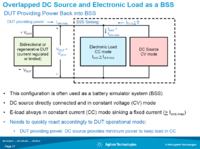GeoAVR
Member level 2

- Joined
- Jun 4, 2014
- Messages
- 48
- Helped
- 0
- Reputation
- 0
- Reaction score
- 0
- Trophy points
- 6
- Activity points
- 366
Dear all,
I want to design an equipment that simulates a battery supply system (multiple battery cells connected together for a Vout =20V).
The problem is that I want to implement a Charge and Discharge function with controlled charging and discharging impedance.
Is it possible to do this with a Programmable power supply i.e. from NI using Labview?
Do I also need a programmable power electronic load connected in parallel with power supply?
What design would you recommend?
Thank you in advance.
I want to design an equipment that simulates a battery supply system (multiple battery cells connected together for a Vout =20V).
The problem is that I want to implement a Charge and Discharge function with controlled charging and discharging impedance.
Is it possible to do this with a Programmable power supply i.e. from NI using Labview?
Do I also need a programmable power electronic load connected in parallel with power supply?
What design would you recommend?
Thank you in advance.




